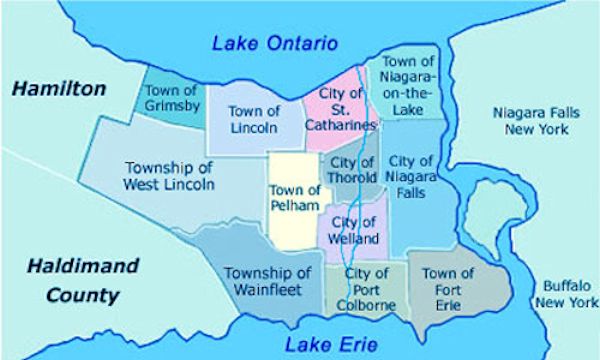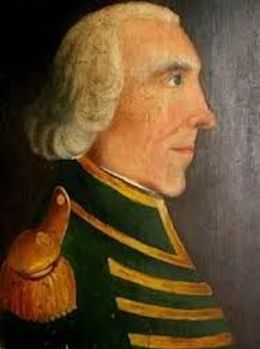
Niagara-on-the-Lake

Niagara-on-the-Lake, Ont, incorporated as a town in 1792, and reincorporated in 1970, population 15 400 (2011c), 14 587 (2006c). The Town of Niagara-on-the-Lake is located where the Niagara River enters Lake Ontario. The Niagara Peninsula has been the home of native people for over 10 000 years. The Neutral Nation who lived here 500 years ago gave the name "Niagara" to the magnificent falls and river. The name means either "thunder of the waters" or, less romantically, "neck."
The first European settlers were refugees fleeing the excesses of the American Revolution in 1778. At the end of the American Revolution, Loyalists who chose not to live in the new republic of the United States were given land grants here and carved new homes out of the wilderness. Under the leadership of John Butler, who had led a regiment of rangers during the revolution, the town of Niagara was laid out on the west bank of the Niagara River.
The settlement was originally known as Butlersburg, in honour of Colonel John Butler, the commander of Butler's Rangers.
The Town received official status in 1781 when it became known as Newark, a British military site and haven for British loyalists fleeing the United States in the volatile aftermath of the American Revolution.
Later, it changed names again, this time to Niagara. Niagara was named the first capitol of Upper Canada (now the province of Ontario), and the first provincial parliament was convened at Navy Hall in 1792 by Lieutenant-Governor John Graves Simcoe.
During the War of 1812, the capitol was moved to York (later to be renamed as Toronto) so as to be farther from the areas of combat.
The Town played a central part in the War or 1812. It was taken by American forces after a two day bombardment by cannons from Fort Niagara and the American Fleet, followed by a bloody battle.
Later in the war the Town was razed and burnt to the ground by American soldiers as they withdrew to Fort Niagara. Undaunted by this setback, the citizens rebuilt the Town after the War, with the residential quarter around Queen Street and toward King Street, where the new Court House was rebuilt out of firing range of the cannons of Fort Niagara.
In the 1880's, the Town was renamed as Niagara-on-the-Lake to avoid confusion with Niagara Falls. The central part is referred to as Old Town or Old Niagara.
Today Niagara -on-the-Lake is a charming historical town set by the Niagara River and Lake Ontario, historic Niagara-on-the-Lake captures attention with its Georgian and Victorian-styled buildings, water front park and surrounding fields of grapevines. Many of Ontario's finest wineries are located here.
The town played a major role in establishing Canada as a new country. Many firsts occurred here, such as Canada's first newspaper. The town has numerous museums and heritage homes to reflect its history, including the Laura Secord Homestead.
The centre of town is composed of artists' studies, craft shops and fine restaurants, along with numerous guest houses and B&B's. The town is home to the Shaw Festival - a months–long series of theatrical productions featuring the works of George Bernard Shaw and his contemporaries.
Visitors flock to dozens of nearby wineries, including those making the world's largest volumes of Icewine . The town is also known for its gardens, art galleries, antique shops and golf courses.
Although the city is the first that comes to mind today when discussing Ontario wines. It was by no means among the area where Canada's early wineries first opened. Pelee Island,,Cooksville, Niagara Fall, Toronto, London and St. Catharines all came before NOTL.
Bordeaux Wine Ltd first licensed in 1926 opened on Queens street in Toronto they built in Niagara-on-the-Lake in 1935. Bought by Chateau-Gai Wine Ltd in 1953 was perhaps the first.
However it was in 1974 the first modern day winery was established in Niagara-on-the Lake. Was it chance or destiny that brought Donald Ziraldo and Karl J Kaiser together in 1971 which resulted in the founding of Inniskillin Wines.
Chateau des Charmes Wine master Paul-Michel Bosc a French grape grower came to Canada and started his family vineyard in 1978.
Reif Estate Winery opened in 1982
The Konzelmann family first established their winery 1984
Lailey Winery started growing grapes 1950's and opened the winery in the 80's
Maleta Estate Winery 1985
The Marynissen family established the winery in 1990
Jackson-Triggs Vintners' inception in 1993
Peller Estate Winery 1991
Pillitteri Estates Winery 1993 vineyards planted 1973
Stonechurch (now Small Talk) The Hunse family began growing grapes in 1972, opening their winery in 1990.
Palatine Hills Estate WineryThe winery came into existence in 2003, but grapes have grown in the Palatine vineyard for over 30 yearsTrius Winery at Hillebrand The winery was originally founded in 1979 by Dr Joseph Poborlry named Newark. He sold it in 1982 to Scoll and Hillebrand from Rheingau, Germany who changed the the name to Hillebrand .In 1994 Andrés acquired Hillebrand Estates Winery. In 2012 they changed the name from Hillebrand winery to Trius at Hillebrand. Today Andres is known as Andrew Peller Ltd. The winery was among the first to produce an Icewine in Ontario 1983
Other well know wineries are Strewn Estate Winery,Stratus Vineyards, Reimer Vineyards, Diamond Estates, Niagara College Teaching Winery, SouthBrook Winery, PondView Estate Winery, Hinterbrook and Riverview Estate Winery
Recent opening include, Two Sisters, The Hare Wine Co. Between the Lines and more
Numerous wineries are located near by in Beamsville, Jordan, Vineland and ST Catherines.
Home | About |Sitemap | History |New | Contact Us |Tourism |©2017 Robert A Bell
